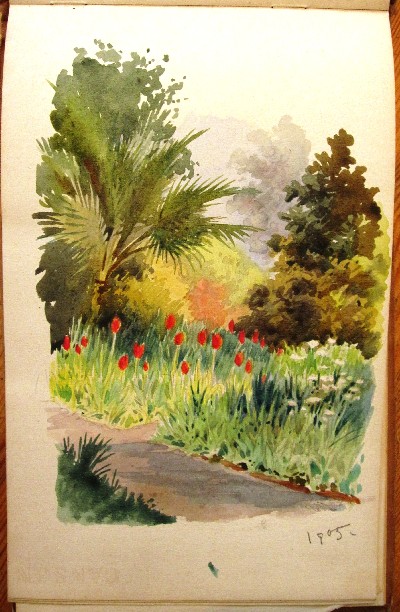
In 1950, St-Tropez became famous by the arrival of movie stars. Bordighera was invented by a different charm of a different era. The foundation of the town of Bordighera dates back to 1470. The palm trees earned the town the name “the Jericho of Italy.” Its public celebrity was launched by novelist and patriot Giovanni Ruffini (1807-1881) who set his Dr. Antonio there. Published in 1855, it was translated into English the same year. It is a love story that depicts Italy in a very favorable light. In 1862, Bordighera is in the guide book – but the same book says “There is nothing that is worth a visit.” Better one should go, as Doctor Antonio did, to the hill above.
“A glorious extent of hilly coast against a background of lofty mountain, stretch semi-circularly from East to West, broken all along its length by capes and creeks, and studded with towns and villages, all of original character.” The railway arrived in 1872, followed shortly by the builders. Instead of “one small and primitive inn, there grew fine hotels. There were some hazards too. “The backs of the old village, poorly exposed but with a great view, is the Hôtel Bella vista hotel. Odors in the neighborhood … are terribly bad. “Better go to the Hôtel des Iles Britanniques!” Bordighera became as exclusively British as Nervi was German.
In winter the English population could reach 5,000 people in a town of 7,000 inhabitants in total. Bordighera today, although there are less palms, is a green and handsome town. It looks well, by contrast with the bare concrete of the new buildings in other resorts of the Riviera. This is how I see it now, but there was a time before these villas. At this time they appeared themselves new and ugly, disfiguring the better and yet older Bordighera. “In those days,” wrote Edward Berry in 1931, “and indeed, until thirty years ago, wild flowers grew in profusion in Bordighera, the country was unenclosed, the olive terraces were free to all-comers, while all the red and purple anemones, violets and narcissus, tulips and gladioli were within reach of us all, in the immediate vicinity of the villas and hotels. 
A good climate, warm and dry, was beneficial. Those with tuberculosis and with wealth followed an annual rhythm, at St Moritz or other alpine resorts in summer and Bordighera or another resort on the Mediterranean in winter.This is one central cause why the Bordighera season was winter while today we go to the Alps in winter and to the sea in summer. A British colony needs it social amenities other than the hotels and the servants in the rental houses. Over time they created a library where they could borrow novels written in their native language in order to read their hotel; Bicknell then built a museum for the city.The English Church was another foundation due to the colony.
 In 1881, the son of Ada, sister of Clarence, Edward Elhanan Berry, moved to Bordighera as a bank manager and agent for the tour operator, pioneer in the field, Thomas Cook’s. He also later became British vice-Consul. Five years later Margaret Serocold visited her family villa for the first time. And in 1897, Edward and Margaret married. In 1904 they laid the foundation stone of the Villa Monte- a photograph of the ceremony (right) sees Bicknell exceptionally wearing a bowler hat. In the years that followed, Berry became the closest friends of Clarence, involving themselves in and supporting almost all his activities. After his death, they became the custodians of what he had created including the Museo Bicknell.
In 1881, the son of Ada, sister of Clarence, Edward Elhanan Berry, moved to Bordighera as a bank manager and agent for the tour operator, pioneer in the field, Thomas Cook’s. He also later became British vice-Consul. Five years later Margaret Serocold visited her family villa for the first time. And in 1897, Edward and Margaret married. In 1904 they laid the foundation stone of the Villa Monte- a photograph of the ceremony (right) sees Bicknell exceptionally wearing a bowler hat. In the years that followed, Berry became the closest friends of Clarence, involving themselves in and supporting almost all his activities. After his death, they became the custodians of what he had created including the Museo Bicknell.
Susie Bicknell, March 2013
Further reading on this web site:
Clarence Bicknell – All Saints Church Bordighera archives
by Graham Avery, original research in 2017 into the archives which are kept in London’s Metropolitan Archives, and the accompanying photos of the archives;
Clarence Bicknell – All Saints Church Bordighera archive photos
Margaret & Edward Berry by Marcus Bicknell on “Edward and Margaret Berry – Vital support for Clarence Bicknell at Bordighera and Casterino” at the Museo Bicknell on 1st June 2013.
Clarence Bicknell – George MacDonald by Susie Bicknell 2015
and other aspects of Bordighera and Riviera life and personalities on the Documents page of this web site.